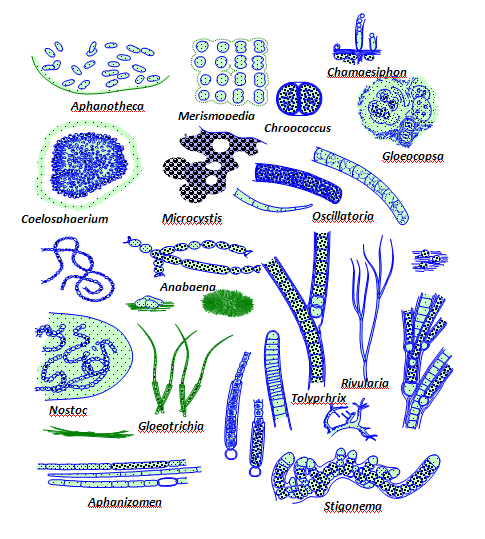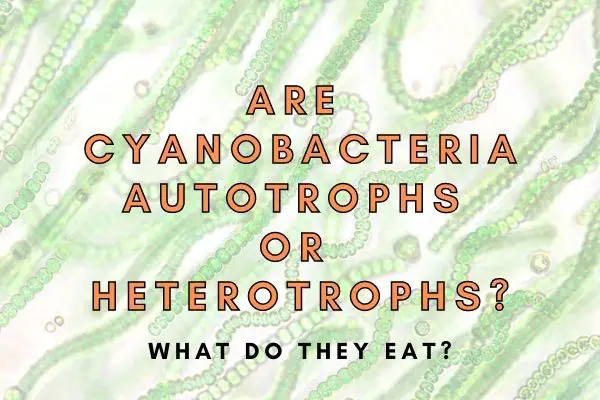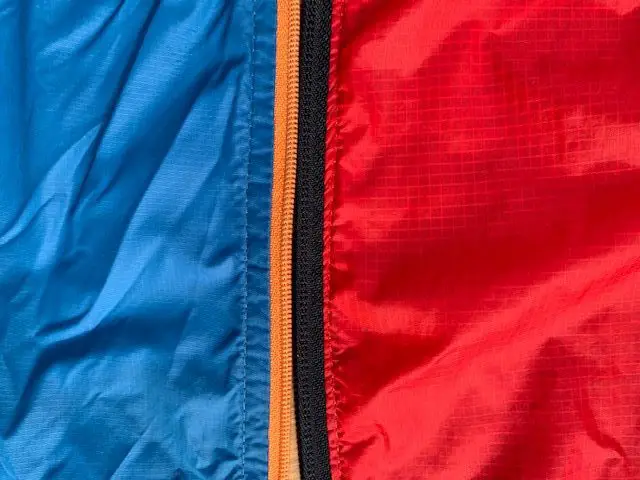Cyanobacteria are a large group of differently shaped bacteria that are all able to perform photosynthesis. They are an important part of the global carbon cycle and produce a large amount of the world’s oxygen. Cyanobacteria are also known as blue-green algae, although they are not actually algae but bacteria.
Cyanobacteria are autotrophs, meaning they can produce their own food from light and simple inorganic compounds. They use the energy from sunlight to convert water and carbon dioxide into organic matter with glucose as their starting point. This process is called photosynthesis and functions the same way in plants.
Cyanobacteria are found in a wide range of habitats including fresh water, marine environments, and even in deserts.
The cyanobacteria are named after the blue-green colors they exhibit. They turn the leaves of plants blue by photosynthesis.
They can live as single cells or form colonies that can be many feet long! Some species of cyanobacteria can fix nitrogen, making them an important part of the nitrogen cycle and aquatic ecosystem as a whole.
Where can cyanobacteria be found?
Cyanobacteria are found in a wide range of habitats, from oceans to deserts. They are found in both temperate and tropical environments.
Cyanobacteria are photoautotrophs, meaning they make their own food using light energy. They are among the most important photosynthesizing organisms in ponds, lakes and oceans.
What do Cyanobacteria eat?
Cyanobacteria are producesr, meaning they make the majority of their own food using light energy and carbon dioxide. So they do not really need to eat to get their energy as heterotroph consumers do. They use photosynthesis to make food, and they produce oxygen.
However, they do also need certain other nutrients and minerals to build their vital proteins and cellular structures. These are minerals like those of vitamin pills eating by humans. They do not provide the cyanobacteria with energy, but rather with functional chemicals to help their metabolism work properly.
For example, minerals such as copper and iron are vital for the photosynthesis and respiration of cyanobacteria.
Some of the minerals eaten by cyanobacteria are:
- Copper (very important for photosynthesis!)
- Iron
- Cobalt
- Zink
- Magnesium
- Calcium
- Nitrogen
Cyanobacteria do also eat organic molecules like the glucose they produce in a process known as respiration (like animals do!) and may also perform respiration when the sun is not around.
What is the Relationship Between Cyanobacteria, Algae and Plants?
Cyanobacteria share the same photosynthetic pathway as plants and algae but otherwise they are very different!
Cyanobacteria are prokaryotic whereas plants and algae are much larger eukaryotic organisms and cyanobacteria are considered to to be the very first photosynthetic organisms.
In fact, cyanobacteria share their photosynthetic pathway with plants likely because the plant cell once engulfed a cyanobacterium that it since domesticated to provide its photosynthetic capabilities!

The numerous shapes of cyanobacteria might suggest that they are closely related to seaweeds or plants, but they are in fact more related for example the salmonella or E. coli bacteria that make you sick!
Are Cyanobacteria Autotrophs or Heterotrophs?
Cyanobacteria are autotrophs because they make their own food by photosynthesis. They are also called producers because they can make their own food. Many bacteria and protozoa are heterotrophs but not cyanobacteria.
Why are Cyanobacteria Autotrophs?
Cyanobacteria are autotrophs because they make their own food using photosynthesis.
Photosynthesis is a process in which plants use sunlight to produce sugar and oxygen. Oxygen is released back into the atmosphere. Plants also release carbon dioxide back into the atmosphere through respiration.
What is Heterotrophy?
Heterotrophs cannot make their own food like autotrophs. They basically take energy from the metabolism of other organisms – essentially from autotrophs! Animals are primary heterotrophs and fungi, as well as many bacteria (except cyanobacteria), are heterotrophs.
However, there are some borderline cases where animals can be considered autotrophs that you can read about here!
What Type of Producer is a Cyanobacteria?
Cyanobacteria are primary producers because they provide the basic nourishment for all the consumers in the ecosystem. Primary producers get all the energy from the sun and make their own food.
Plants are producers, whereas primary and secondary consumers are herbivores and carnivores that directly or indirectly live off of cyanobacteria or plants!
What is the ecological function of Cyanobacteria?
Cyanobacteria are the first trophic level in the food chain because they are primary producers.
They produce the basic nourishment for the consumer organisms at higher trophic levels.
They do not function as decomposers, but rather get their minerals and building blocks thanks to the decomposers (mainly bacteria and fungi) releasing nutrients back into the water.
However, when most people think of cyanobacteria they think of the harmful ones: the blue-green algae that can make us sick in lakes and ponds, but it is important to remember that many species of cyanobacteria are good for us (in the grand scheme of things!) in our water environments as they are not toxic but mainly serve as food for other species!
What Organisms Eat Cyanobacteria?
cyanobacteria are producers, but not all bacteria are, and many other bacteria, protozoa and animals eat cyanobacteria.
A new study by Nierenberg, Dolan, and their colleagues shows that a surprising fraction of the blooms of cyanobacteria, called cyanobacteria blooms or CBs, are consumed by tiny eukaryote heterotrophs such as diatoms, coccolithophores, and other larger planktons.
Also, most filter feeders such as crabs, crayfish, whales and even flamingos will eat a substantial amount of cyanobacteria!
Tadpoles, Paramecium and Euglena are other good examples of organisms that eat cyanobacteria!
Conclusion
In this post I have looked into the diet of cyanobacteria and how they get their energy as group of bacteria that can produce their own food.
They are, however, not the only type of autotrophic bacteria as there are also other bacteria that can make their own food but without sunlight! These are called chemoautotrophic bacteria and you can read about them here.
The conversion of light to sugars (energy) by cyanobacteria is a vital part of the ecosystems and provides the raw material for the food chain. Without them there would be many different creatures that could not survive.
So think about that next time you swim is ruined by a dark green mass in the water…
You might also be interested in my recent post on another interesting organism that uses photosynthesis but can actually be considered an animal! Or actual animals that can do photosynthesis!




